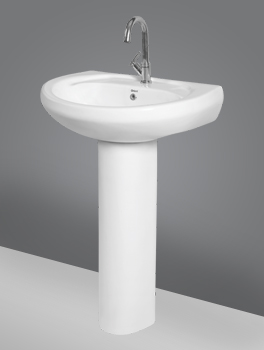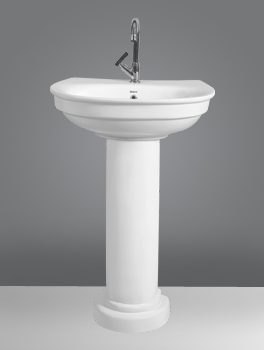
The following article describes the basic process for manufacturing ceramic wash basins that is followed by Wash basin manufacturers in India. It covers the ceramic materials used, Body preparation, Kiln firing, and Hand tools. After you have finished reading this article, you should feel more confident choosing ceramic wash basins from Sanitary ware manufacturers and exporters India.
Ceramic Materials for Ceramic Wash Basin
The ceramic wash basin manufacturing process involves several steps. And, during this process, the ceramic product undergoes visual inspection, flushing tests, chemical resistance, and abrasion.
The first ceramic manufacturing factory was established in 1759 by Josiah Wedgwood in Stoke-on-Trent, England. Karl Bayer developed a process to separate alumina from its other components in 1888, which is still used today. In 1880, Pierre and Jacques Curie discovered the phenomenon of piezoelectricity in Rochelle salt. It has become a key property of electro ceramics.

High-performance ceramics have superior electrical and mechanical properties. They are extremely strong and lightweight, and their heat resistance is much greater than the previous ceramics. Ceramic powders are made from uniform-size particles. Ceramics are less prone to fracture. Thin ceramic fibres increase tensile strength and are used in electronics.
Traditional ceramic raw materials are clay minerals, which are recycled and reused. More recent materials are aluminium oxide and tungsten carbide, which are both highly abrasion-resistant. Ceramic materials are used in everything from body armour to aerospace parts. They're the stuff of our everyday lives, and they're still being developed. There's no end to the applications for these materials.
How is Ceramic Wash Basin Body Preparation done?
The manufacturing process for sanitary wares begins with body preparation. A mixture of clays, called slips, is mixed to form the basin body. These clays are made up of china clay, silica, and ball clay. They are then moulded into a tri-axial body, which includes a body former and a filler. Finally, a flux is added to lower the fusion temperature of the finished product.
The materials used in the production process for ceramic washbasins by Wash basin manufacturers in India, are mainly composed of three phases: the matrix, the additives, and the body. The matrix is the most common phrase, as it contains crystalline components. The additives are dispersed or scattered in the matrix. Both the grain size and geometry of the grains determine the type of material used for the final product. Pores are formed by two processes: the shrinkage of the matrix and the rate of cooling. These phases vary in colour from yellow to beige.
How is Kiln Firing Done for Manufacturing Ceramic Wash Basin?
The ceramic wash basin manufacturing process begins with the preparation of the basin body. The ceramic material is then placed in a kiln. The kiln maintains a temperature of fifty to sixty degrees, which corresponds to a range of twelve to fourteen hundred degrees Fahrenheit. The product will be dried to about seventy per cent of its original volume. It is then sent to the kiln for kiln firing.
Fuel-fired kilns should be started with pilot lights. When firing, the kiln should be completely closed, with the door and spyholes closed. The kiln should have at least a foot clearance around it. When the kiln has reached the desired temperature, the lid and any other openings should be unplugged. The pottery must be completely cooled before it can be removed from the kiln. When firing the ware, the kiln should be cooled down before being touched. If it is still hot after firing, turn off the kiln immediately and check the electrical outlets and power cords.
Electric kilns are the most common type of kiln for firing ceramic wash basins in Furniture wash basin Manufacturer in India. These ovens use a long heating stage at around 200 degrees F, just below the temperature at which moisture turns to steam. Because the clay must completely dry before reaching this temperature, firing it too fast could result in an explosion.

What are Hand Tools for Ceramic Wash Basin Manufacturing?
The hand tools used in the ceramic wash basin manufacturing process can be described as measuring instruments. A calliper is used to measure the length and width of pieces, such as lids and bases for jars. A pottery knife has thin, hard-tempered blades that are useful for cutting different areas of the slab and trimming the sides of the basin. Hand tools are an essential part of the ceramic wash basin manufacturing process.
The hammer, for example, is a common hand tool used during the ceramic wash basin manufacturing process. The hammer's mechanical energy dissipates as the layers of atoms jump past each other. Unlike metal, ceramics are too dense to bend and will break if struck. The tools used in the ceramic wash basin manufacturing process are therefore essential. They make the process easier and faster.
The ceramic wash basin manufacturing process is ongoing. The basic materials used for the product are feldspar, quartz, and clay. The raw materials are proportionally added to a pump and filtered in a mud pool. Before moving on to the next process, the compositions are checked for consistency. Hand tools used in the ceramic wash basin manufacturing process are sandpaper, repairing knives, and brushers. The hand tools used in the ceramic wash basin manufacturing process by sanitary ware manufacturers and exporters in India are necessary to produce high-quality and durable products.
What is Cleaning Process of Ceramic Wash Basin?
The basic materials used in the manufacturing of a ceramic wash basin are proportionally added to a water pump. The clay is then filtered into a mud pool to check for composition. The next step is to pour the mixture into the production moulds. During the entire process, the clay is stirred continually. Pipes then transfer the clay into the moulds.
Once the final product is ready for use, it will be glazed. Unlike conventional ceramic washbasins, the glazed surface can be cleaned easily. Some basins by Sanitary ware manufacturers in India have designs printed on them to increase their aesthetic value. The most attractive features of porcelain washbasins are that they are affordable and available in an assortment of structures and colours. And what's best about them? They're easy to clean and they're surprisingly durable.
The Bottom Line
A very competitive market exists for ceramic washbasins worldwide. Considering that ceramic washbasins have a highly sturdy surface that is resistant to impacts, scratches, and chipping, they can survive the rigours of daily usage. Moreover, ceramic wash basins are the best choice for products that will be used often due to these characteristics.

Make an Appoinment
Send us Message
Visit us at Address
Vagadiya Road, Thangadh - 363530,
Gujarat, India.
Gujarat, India.
© Copyright 2026, Orient Ceramics, All Rights Reserved.
Web Design & Development by Opal Infotech